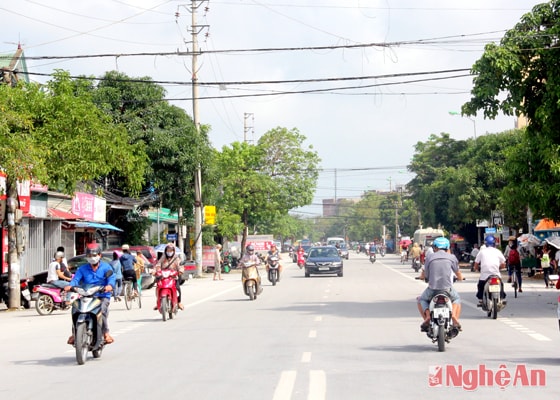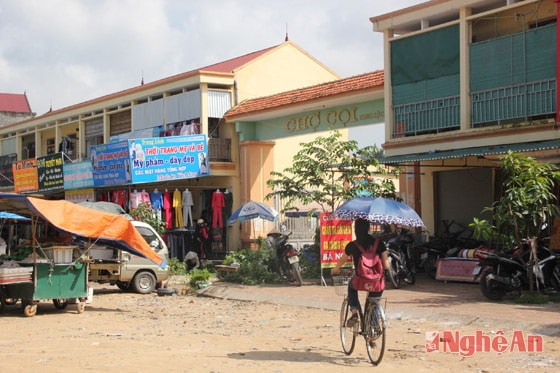Le Viet Thuat Street - Old features on a new street
(Baonghean) - The spacious street has the appearance of a gateway to Vinh City, a dynamic and integrated city, but there is still a lingering nostalgia for the old ways of the land with a rich history, culture and revolution. Those are my feelings about Le Viet Thuat Street...
 |
| A section of Le Viet Thuat Street. |
For the people of the heroic Red City, that road has been familiar since it was a deserted trail in the early 1800s of the 19th century. Until the early 50s of the 20th century, the French colonial government expanded it, and Le Viet Thuat Street connecting Vinh - Cua Hoi became an important inner-city traffic route. Today, Le Viet Thuat Street is also known as Provincial Road 535, managed by the Nghe An Department of Transport, starting from the Post Office Bridge - the intersection of Nguyen Sy Sach and Nguyen Phong Sac Streets. That is to say, the road is not just a familiar trail as it was meant to be nearly 2 centuries ago, but has emerged as an "indissoluble bloodline" of a first-class urban area.
Le Viet Thuat Street is located right in the heart of the heroic Hung Loc land, stretching through the hamlets of Tan Hung, Xuan Hung, Mau Don, Mau Lam, Ngu Phuc... I have leisurely walked on Le Viet Thuat Street many times, and in the end, I still hesitated and was absorbed in front of the "Mau Don Culture" gate leading to the thick sediment area, urging me to explore and learn. In the near future, the residents of Mau Don hamlet - residents of a part of Le Viet Thuat Street - will celebrate 10 years since the hamlet was honored to be recognized as a provincial-level Cultural Hamlet. Those 10 years must also be a round number in terms of titles and documents, but the cultural quality, the depth of the land and people here must have been counted from hundreds of years ago. Since ancient times, this area also had a Mau village temple, majestic and sacred, famous far and wide. The temple is a place for the villagers to rely on their spirituality, and also has the meaning of guarding against bad things. The spirit of the Mother Temple has permeated the daily life of the villagers, and until now, through many centuries, it still rhythmically nourishes a peaceful mind. Even Le Viet Thuat Street, which only passes through the hamlet for the first 500m, has also benefited from that immense blessing, breathing into its breath today a tranquil atmosphere, despite the hustle and bustle of change.
Walking on Le Viet Thuat Street today, we are recalling the footsteps of our ancestors, of history. That is, the thunderous and angry atmosphere of thousands of Loc Da - Duc Thinh people in the high tide of the Nghe - Tinh Soviet movement; or the deep American bomb craters, the famous anti-aircraft artillery positions in the sky of Vinh City. The original residents of this area, now recalling, hardly dare to believe that one day, the road that witnessed so many changes of the land and people here, would have such a strong rise. From a dusty road mixed with sand in the hot season, muddy in the rainy season, which used to be a misery for many people passing by, it is now spacious and majestic with two lanes going in and out, a couple of rows of houses and shops close together, full of convenient food stalls. The most obvious feeling of the street's atmosphere is on a chilly afternoon like this season, amidst the hustle and bustle of work and the hardships of a day that has ended, the lingering aromas of hot pot restaurants, barbecue restaurants, dog meat restaurants... are increasingly present on the street, shaping the unique culinary style of Le Viet Thuat Street.
 |
| Coi Market (Hung Loc commune). |
This road still bears the mark of Coi market - a traditional market that has been present in Hung Loc for almost a hundred years? In the memory of people of "old and rare" age, Coi market is simply a rural market, selling a few trays of vermicelli, a few shiny cakes with scallion oil, a few stalls of red-roasted meat and three or four rows of vegetables, rice, etc. The name is also unknown where it came from. Some people say that Coi is a mispronounced name for Coi - meaning sedge mats - a commodity that was once quite popular in this market. Others say that it is not, Coi also means Coi, but it is a sedge bird (same family as storks) that used to live in the marshy areas of Hung Loc in the old days. I do not dare to affirm which explanation is correct, I only know that the market has created a unique urban style until today. Although it has been more than 2 years since Coi market was invested in a new 2-storey market with more than 8,600m2, the rural market atmosphere has faded, but Le Viet Thuat street still enjoys the full hustle and bustle of that somewhat intimate shopping place until late at night.
The street is located on a historical revolutionary sediment area, so as if it were impossible otherwise, the heroic spirit still resonates in the street's sound, the people of the street are still straightforward, simple and chivalrous. I know a man who owns a restaurant in the middle of Le Viet Thuat Street. He is the youngest son of a veteran of the 280th Anti-Aircraft Artillery Regiment. His father's memories of the American bombings, the earth-shattering explosions, the landslides that plowed the small city that had not yet revived after years of defending the homeland, and the cheers of victory, the tears of happiness on reunion days... have become a fairy tale that has accompanied him throughout his childhood. He loves this city that still has many hardships from his father's heroic memories, and above all, it has become an anchor that keeps him here, determined to get rich on his homeland. His restaurant faces Le Viet Thuat Street, and its main customers are students, ordinary workers and low-paid civil servants. A few vegetables, a few pieces of meat, a bowl of hot soup and a tightly packed bowl of rice… for many years, simply and lovingly treating many people in need. It is not exactly a free meal restaurant, because the owner himself is not well off, but whenever he enters the restaurant, customers can confidently and happily eat with their not much money…
Excited and happy on Le Viet Thuat Street, with the meaning of the street being the gateway to the Northeast of the city, having a strong reach to the Cua Hoi - Cua Lo beach tourism center, connecting directly to the "heart" of Vinh City's inner city, but still somewhat unable to shake off the suburban melancholy. On the rare sunny days of late Autumn, leisurely driving to the end of the street, I feel my mind growing a hope for the street tomorrow.
| Le Viet Thuat was born in 1902 in a poor family in De Thap Street (now Ben Thuy Ward), Vinh City. At the age of 14, he followed his elders to work as a worker in the Match Factory. Witnessing the hard labor every day and his body being beaten by the owner of the Match Factory, he was extremely angry and he began to awaken to class and national consciousness. After the Phuc Viet Association was established, Le Viet Thuat was admitted to the association and became a member of the Trade Union organization. On June 17, 1929, the Indochinese Communist Party was established in the North and developed its organization in the Central region, becoming the core of the Indochinese Communist Party organization in the working class. From a Tan Viet Party member, Le Viet Thuat became a Party member and Secretary of the Indochinese Communist Party Cell of the Truong Thi Factory in 1929. After the Conference to establish the Indochinese Communist Party (February 3, 1930), Vinh Provincial Party Committee was formed with Le Mao as Secretary, Le Viet Thuat as a member of the Vinh Provisional Provincial Party Committee. From April 1931, the leading cadres of the Regional Party Committee sacrificed one after another and fell into the enemy's net. In early 1932, the Central Region Party Committee agency was exposed, comrade Le Viet Thuat - the last Regional Party Committee Secretary fell into the enemy's hands. After a period of suffering torture from the enemy at Vinh Prison, comrade Le Viet Thuat sacrificed in March 1932. |
Phuong Chi






